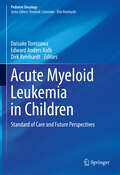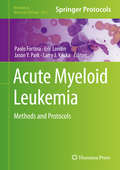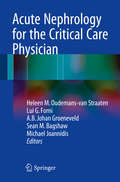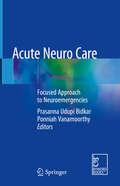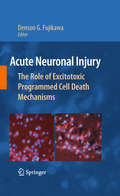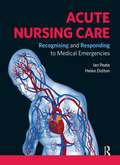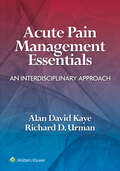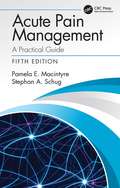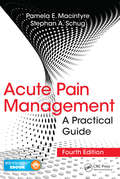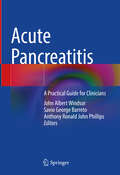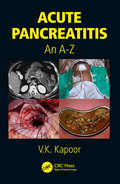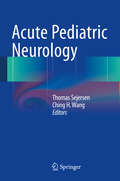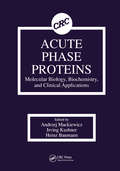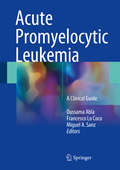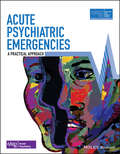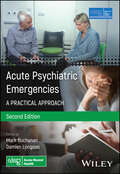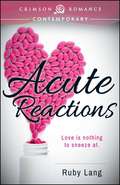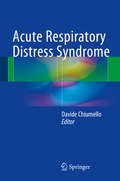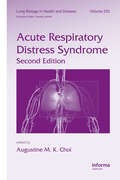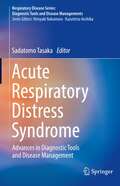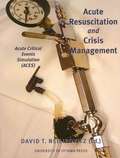- Table View
- List View
Acute Myeloid Leukemia in Children: Standard of Care and Future Perspectives (Pediatric Oncology)
by Dirk Reinhardt Daisuke Tomizawa Edward Anders KolbThis book provides up-to-date information on key topics and issues in Pediatric Acute Myeloid Leukemia (AML), including the epidemiology, biology, diagnosis and treatment of particular forms of the disease, supportive care, and survivorship. The entire spectrum of clinical management on pediatric AML is covered with the aim of equipping readers with the latest knowledge relevant to clinical practice and research, based on enormous efforts made by cooperative clinical trial groups and consortia worldwide. Each chapter is written by internationally renowned authorities who have been selected for their expertise in the subjects discussed. This book will serve pediatric hematologists/oncologists, fellows, and residents both as a comprehensive source of information and as a quick reference. The book will also be of interest to pediatricians and general practitioners.
Acute Myeloid Leukemia: Methods and Protocols (Methods in Molecular Biology #1633)
by Paolo Fortina Eric Londin Jason Y. Park Larry J. KrickaThis volume describes up-to-date techniques used in understanding the molecular biology of acute myeloid leukemia (AML) and addressing advances in diagnosis, classification, prognostication, and therapeutic strategies to potentially impact overall patient survival. The chapters in this book cover topics such as: cytochemical staining, single-cell mass cytometry of AML and Leukemia stem/progenitor cells, microsphere-based assessment of DNA methylation for AML prognosis, a zebrafish model for evaluating the function of human leukemic gene IDH1 and its mutation, and the isolation of biologically active exosomes from plasma of patients with cancer. Written in the highly successful Methods in Molecular Biology series format, chapters include introductions to their respective topics, lists of the necessary materials and reagents, step-by-step, readily reproducible laboratory protocols, and tips on troubleshooting and avoiding known pitfalls. Cutting-edge and practical, Acute Myeloid Leukemia: Methods and Protocols is a valuable resource for scientists and researchers to further their studies and advancements in the field of AML.
Acute Nephrology for the Critical Care Physician
by Heleen M. Oudemans-van Straaten Lui G. Forni A.B. Johan Groeneveld Sean M. Bagshaw Michael JoannidisThis practical guide provides the reader with answers to important clinically relevant questions regarding the evaluation and management of acute kidney injury (AKI). All aspects of critical care nephrology are covered, from pathophysiology and diagnosis to prevention and treatment. The questions considered relate to a wide range of issues, such as: How do I diagnose AKI? How can I protect the kidney in clinical practice? How do I manage patients with AKI? When should I initiate and how do I perform renal replacement therapy (RTT)? Which type of RTT is most appropriate for my patient? Should I give specific nutrients? In addition to providing practical guidelines and treatment algorithms, the book includes calculators for continuous RRT and anticoagulant dosing. The authors are internationally renowned experts in the fields of Intensive Care Medicine and Nephrology and all contributions are written in a clear and concise style and have been peer reviewed. Acute Nephrology for the Critical Care Physician will serve as a very useful source for intensivist internists, anesthesiologists and nephrologists involved in the management and treatment of critically ill patients at risk of or affected by AKI.
Acute Neuro Care: Focused Approach to Neuroemergencies
by Prasanna Udupi Bidkar Ponniah VanamoorthyThe book provides detailed information on all major neuroemergencies, and includes a detailed checklist for practical care during the first hour of an emergency. Reinforcing the concept of quality care for better outcomes in patients with neurological diseases, the book discusses approaches to comatose patients, neurological evaluation, neuropharmacology, neuroradiology, traumatic brain and spine injury, and various other neurological disorders. The field of neuroanesthesiology and neurocritical care has expanded with the advent of newer, complex surgeries, and neurocritical care is becoming an established subspecialty of neuroscience. Neurological emergencies require special care since prevention of secondary damage to the brain is of paramount importance. A valuable resource for intensivists, neurointensivists, emergency medicine physicians, neurology and neurosurgeons and nursing professionals involved in neurocare, this book also serves as study material for participants of the two-day course on “Acute Neuro Care” designed by the Indian Society of Neuroanesthesiology and Critical Care (ISNACC).
Acute Neuronal Injury: The Role of Excitotoxic Programmed Cell Death Mechanisms
by Denson G. FujikawaThe purpose of this book is to present clinically relevant basic mechanisms of excitotoxic neuronal death, which in the adult mammalian brain is morphologically necrotic, not apoptotic, and which involve caspase-independent mechanisms of programmed cell death. The spectrum of clinically relevant pathologically induced excitotoxic neuronal death includes cerebral ischemia, traumatic brain injury, cerebral hypoglycemia, and status epilepticus. By investigating mechanisms, potential neuroprotective strategies can be identified that may have future clinical application.
Acute Neuronal Injury: The Role of Excitotoxic Programmed Cell Death Mechanisms
by Denson G. FujikawaAn overview of the biochemical mechanisms that produce acute nerve cell death in the brain. Covers injuries and disorders including stroke, brain and spinal cord trauma, hypoglycemic coma, and prolonged epileptic seizures. All of these lead to high concentrations of calcium in nerve cells which, in turn, causes degradation of cytoplasmic proteins, cleavage of nuclear DNA, and eventually cell death. The Second Edition contains 11 thoroughly updated chapters and 3 additional chapters that did not appear in the previous edition.
Acute Nursing Care: Recognising and Responding to Medical Emergencies
by Ian Peate Helen DuttonDelays in recognising deterioration or inappropriate management of people in acute care settings can result in late treatment, avoidable admissions to intensive care units and in some instances unnecessary deaths. As the role of the nurse in healthcare settings continues to change and evolve, today's student nurses need to be equipped with the fundamental skills to recognise and manage deterioration in the patient in a competent and confident manner, as you learn to become practitioners of the future.Using a body systems approach and emphasising the central role and function of the nurse throughout, this book provides a comprehensive overview of the essential issues in this important subject. Topics covered include: recognition and identification of physiological deterioration in adults; identification of disordered physiology that may lead to a medical emergency linked to deterioration of normal function; relevant anatomy and physiology; pathophysiological changes and actions that need to be taken; immediate recognition and response; investigations, diagnosis and management issues; and teaching and preventative strategies.
Acute Nursing Care: Recognising and Responding to Medical Emergencies
by Ian Peate and Helen DuttonDelays in recognising deterioration, or inappropriate management of people in acute care settings can result in late treatment, avoidable admissions to intensive care units and, in some instances, unnecessary deaths. As the role of the nurse in healthcare settings continues to change and evolve, today's nursing and other healthcare students need to be equipped with the fundamental skills to recognise and manage deterioration in the patient in a competent and confident manner, appreciating the complexities of caring for those who are acutely unwell as you learn to become practitioners of the future. Using a body systems approach, and fully updated in light of new NEWS2 and NMC future nurse standards, as well as acknowledging the challenges faced by people with delirium in acute care settings, the second edition of this book provides a comprehensive overview of the essential issues in this important subject. Topics covered include recognition and identification of physiological and mental deterioration in adults; identification of disordered physiology that may lead to a medical emergency linked to deterioration of normal function; relevant anatomy and physiology; pathophysiological changes and actions that need to be taken; immediate recognition and response; investigations, diagnosis and management issues; and teaching and preventative strategies. Including case studies and test yourself questions, this book is an essential tool for student nurses who are required to undertake acute care experiences and are assessed in theory and practice.
Acute Pain Management
by Raymond S. Sinatra Henry Mcquay Oscar A. de Leon-Casasola Brian Ginsberg Eugene R. ViscusiThis textbook is written as a comprehensive overview of acute pain management. It is designed to guide clinicians through an impressive array of different options available to them and to patients. There has been a flurry of interest in the extent to which acute pain can become chronic pain, and how we might reduce the incidence of such chronicity. This overview covers a wide range of treatments for pain management, including the anatomy of pain pathways, the pathophysiology of severe pain, pain assessment, therapeutic guidelines, analgesic options, organization of pain services, and the role of anesthesiologists, surgeons, pharmacists, and nurses in providing optimal care. It also discusses the use of patient-controlled analgesia and how this may or may not be effective and useful.
Acute Pain Management Essentials: An Interdisciplinary Approach
by Richard D. Urman Alan David KayeCovering both surgical and non-surgical pain, Acute Pain Management Essentials is a comprehensive, clinically oriented reference for the entire acute pain management team. Edited by Drs. Alan David Kaye and Richard D. Urman, this new title brings together the expertise of contributing authors from anesthesiology, medicine, surgery, and allied health professions to offer an interdisciplinary approach to this complex and fast-changing field. Beginning with an overview of basic principles, it then approaches pain management by organ system, by patient population, and by treatment modality, ending with review of subspecialty considerations and related topics.
Acute Pain Management: A Practical Guide
by Pamela E. Macintyre Stephan A. SchugWith a focus on practical acute pain management in adults in the hospital setting, this book provides health professionals with simple and practical information to help them manage patients with acute pain safely and effectively. • Combines evidence-based information with practical guidelines and protocols • Covers the pharmacology of opioids, local anesthetics, and nonopioid and adjuvant analgesic agents • Discusses management of acute pain in both surgical and nonsurgical acute pain settings including in patients with spinal cord or burns injuries and selected medical illnesses • Includes evidence-based information about management of acute pain in some specific patient groups , including the older patient, opioid-tolerant patients, and those with addiction disorders, pregnant or lactating patients and patients with obstructive sleep apnea or who have renal or hepatic impairment • Considers the role of acute pain management in the context of the current opioid epidemic and identifies possible strategies to minimise the risks. This resource will be helpful to a variety of professionals in assessing and managing acute pain.
Acute Pain Management: A Practical Guide, Fourth Edition
by Pamela Macintyre Stephan SchugHighly Commended, BMA Medical Book Awards 2015Comprehensive acute pain management no longer means only caring for patients with pain resulting from postoperative and trauma-related causes-it now includes managing patients with acute pain arising from a wide variety of conditions. Acute Pain Management: A Practical Guide provides health professional
Acute Pancreatitis: A Practical Guide for Clinicians
by Savio George Barreto John Albert Windsor Anthony Ronald John PhillipsThis book is an accessible, evidence-based, succinct and practical reference for those providing hands-on care to patients with acute pancreatitis. It represents the most updated results of clinical science and offers the frameworks that underpin the disease and its management. The first part of the book presents the latest clinical science and illustrates a clear indication of what is known, and what are the gaps in our understanding of the disease. The second part provides practical clinical management guidelines. The chapters are designed to bring recommendations, practical points to facilitate navigation, easy access of knowledge, and highlights key decision points and options.Acute Pancreatitis - A Practical Guide for Clinicians is relevant to not only clinicians involved in patient care but medical, nursing and dietitian students, surgical and gastroenterology researchers, companies and agencies. The book comprehensively covers acute pancreatitis, associating it with local pancreatic complications, systemic inflammation and organ failures, also providing management algorithms. This practical reference book is an introduction to disease management, indicating why topics addressed in each chapter are essential, providing valuable guidance for day-to-day treatment by professionals globally.
Acute Pancreatitis: An A-Z
by V.K. KapoorAcute pancreatitis is a common cause of acute abdomen. Diagnoses is difficult as the symptoms mimic that of many other medical and surgical conditions. Patients with severe acute pancreatitis can develop multiple organ failure and need intensive care. As its management is multi-disciplinary involving gastroenterologists, radiologists and surgeons, this book shall appeal to every doctor, irrespective of the specialty. This focused book conveys the knowledge of the basic concepts of acute pancreatitis in an innovative way. Original photographs and figures are used for the better understanding of the readers. In this pocketbook, various aspects related to acute pancreatitis are covered in a unique, simple and easy-to-read A-to-Z format and will be useful to medical students, post-graduate trainees and practicing doctors as a ready reckoner for pancreatitis. Key Features: • Innovative and unique A - Z format. • focuses on signal knowledge and fast clinical management of various facets of different types of acute pancreatitis. • Comprehensive approach with interesting facts. • Lucid and self-explanatory text. • Can be used as a ready reckoner pocketbook .
Acute Pediatric Neurology
by Thomas Sejersen Ching H. WangThis book provides recommendations for evaluation and therapy in the area of acute pediatric neurology; these are presented didactically with frequent use of illustrations and algorithms. Chapters in the first part of the book discuss presenting symptoms of acute neurological conditions. The second part of the book covers major areas of acute pediatric neurology and each of these chapters has three key elements: description of presenting symptoms; recommended assessments; and recommended interventions. Acute Pediatric Neurology provides an accessible, clinically focused guide to assist physicians in the emergency ward or intensive care unit in decisions on diagnosis and therapeutic interventions in all major acute pediatric neurological diseases.
Acute Phase Proteins Molecular Biology, Biochemistry, and Clinical Applications
by Irving Kushner Andrzej Mackiewicz Heinz BaumannAcute Phase Proteins covers all major aspects of acute phase proteins (APP) starting with molecular mechanisms regulating their synthesis and ending with their functional significance. The book features 36 chapters addressing such topics as acute phase response and the APP; major APP and their structure and functions; regulation of APP synthesis, the cytokines and hormones implicated in these processes, and molecular mechanisms involved; signal transduction of cytokines in hepatocytes and posttranscriptional processes; and quantitative and qualitative evaluation of APP in clinical practice. The book will be an important reference for immunologists, molecular biologists, cellular biologists, biochemists, and clinical chemists.
Acute Promyelocytic Leukemia: A Clinical Guide
by Oussama Abla Francesco Lo Coco Miguel A. SanzThis book provides a comprehensive overview on the clinical issues and biology of acute promyelocytic leukemia (APL) and on the molecular mechanisms of targeted therapy with ATRA and ATO. The text covers major topics such as the pathophysiology of APL coagulopathy, biologic and clinical differences between children and adults with APL, and the role of minimal residual disease monitoring. Additionally, the book summarizes historical, current, and future treatment strategies in both adults and children, while highlighting the most recent therapeutic recommendations for relapsed disease and the evolving indications for autologous and allogeneic stem cell transplant. This volume also features chapters focusing on secondary APL and therapy, late effects, rare presentations such as APL in the elderly and during pregnancy, and rare APL variants that may represent therapeutic challenges.
Acute Psychiatric Emergencies (Advanced Life Support Group)
by Advanced Life Support Group (ALSG)Acute Psychiatric Emergencies is designed for all medical and healthcare professionals working with patients in mental health crisis. This manual is a key component of the Acute Psychiatric Emergencies (APEx) course, which uses a structured approach developed by leading psychiatry and emergency medicine specialists with years of practical experience. This valuable resource provides a practical approach for dealing with mental health emergencies, helping healthcare professionals from different specialties speak a common language and develop a shared understanding that expedites excellent care. The manual outlines the assessment and management of patients who have self-harmed, those that are apparently drunk, the patient behaving strangely, the patient with acute confusion, and those that are aggressive. Presents a structured, practical approach for the emergency care of patients presenting in acute psychiatric crisis Covers common presentations of psychiatric emergencies Emphasises close co-operation of emergency and mental health teams Offers content designed jointly by practicing psychiatrists and emergency physicians from the Advanced Life Support Group (ALSG) Acute Psychiatric Emergencies will be useful for practitioners of emergency medicine, psychiatry, emergency and mental health nursing as well as other mental health and crisis care professionals.
Acute Psychiatric Emergencies: A Practical Approach (Advanced Life Support Group)
by Advanced Life Support Group (ALSG)An essential guide to the emergency treatment of mental health crises Hospital emergency departments are encountering increasing numbers of patients in mental health crises and the number continues to rise year on year. Despite these challenges, very few practitioners are trained specifically to deal with mental health crises. Acute Psychiatric Emergencies (APEx) meets this need with a course designed jointly by leading psychiatry and emergency medicine specialists with years of practical experience. It will help in any crisis setting be it in the emergency department, ward, clinic or in the community. APEx provides a structured approach for the assessment and management of acute mental health emergencies, discusses common presentations, as well as legal frameworks and human factors. Now fully updated to reflect new guidelines and expanded treatment of key subjects, it is an invaluable resource for any practitioner involved in the provision of psychiatric care at any point in the healthcare pathway. Readers of the second edition of Acute Psychiatric Emergencies will also find: Detailed discussion of topics including organic causes for behavioural disturbances, special circumstances and moreUpdated algorithms and figures for improved accessibilityAn emphasis on close cooperation between emergency and mental health teams APEx is ideal for emergency physicians, psychiatrists, emergency and mental health nurses, paramedics and other crisis care professionals. Advanced Life Support Group (ALSG) is an organisation dedicated to improving outcomes for people in life-threatening situations, anywhere along the healthcare pathway, anywhere in the world. A leading medical education charity, ALSG has delivered advanced life support training to over 225,000 clinicians in 44 countries.
Acute Reactions
by Ruby LangThe man with allergies never gets the girl, at least according to the movies - and Portland restaurateur Ian Zamora wants to be the guy who gets the girl. So to rid himself of the sensitivities brought on by his sometimes-girlfriend's cat, he makes an appointment with allergist Petra Lale. But he suddenly finds himself acutely attracted to the very woman who is supposed to be helping him take care of his problem.Petra's intrigued by Ian's quiet strength and sexy body, but her solo practice is new and struggling. She can't afford to compromise her ethics - or risk her medical license - by dating a patient. Falling in love certainly wasn't this doctor's order. She tries to stay away from Ian, but fate, and her weak willpower, keep bringing them back together. Do two career-driven people with inexperienced hearts stand a chance of finding the right prescription for love?Sensuality Level: Sensual
Acute Reactions (Practice Perfect Book #1)
by Ruby LangThe man with allergies never gets the girl, at least according to the movies - and Portland restaurateur Ian Zamora wants to be the guy who gets the girl. So to rid himself of the sensitivities brought on by his sometimes-girlfriend's cat, he makes an appointment with allergist Petra Lale. But he suddenly finds himself acutely attracted to the very woman who is supposed to be helping him take care of his problem.Petra's intrigued by Ian's quiet strength and sexy body, but her solo practice is new and struggling. She can't afford to compromise her ethics - or risk her medical license - by dating a patient. Falling in love certainly wasn't this doctor's order. She tries to stay away from Ian, but fate, and her weak willpower, keep bringing them back together.Do two career-driven people with inexperienced hearts stand a chance of finding the right prescription for love?Sensuality Level: Sensual
Acute Respiratory Distress Syndrome
by Davide ChiumelloThis book covers all clinical aspects of acute respiratory distress syndrome (ARDS), from definition to treatment, focusing on the more recent recommendations and evidence-based medicine. The addressed topics are the various ventilation strategies, the impact of prone positioning, the use of partial and total extracorporeal support, the value of vasodilators, the weaning from mechanical ventilation, the pharmacological interventions, noninvasive ventilation, and the strategies using anti-inflammatory agents and stem cells. Furthermore, different related topics are also discussed, such as lung imaging, sedation, metabolic support, and hemodynamic instability. A concluding chapter specifically addresses ARDS in children. This up-to-date volume, written by experts in the field, will be of value for all health care practitioners seeking state of the art on the management of patients with this complex syndrome.
Acute Respiratory Distress Syndrome (Lung Biology in Health and Disease)
by Augustine M. K. ChoiThe only available text to focus primarily on Acute Respiratory Distress Syndrome (ARDS).Thoroughly revised content and ten new chapters provide pulmonologists with the latest developments and applications of pharmacological and mechanical therapies needed to treat the debilitating and difficult condition of ARDS.Highlights include:the definition,
Acute Respiratory Distress Syndrome: Advances in Diagnostic Tools and Disease Management (Respiratory Disease Series: Diagnostic Tools and Disease Managements)
by Sadatomo TasakaDivided into thirteen chapters, this book provides a wealth of research-oriented findings and practical guidance, ranging from the definition, epidemiology and pathophysiology, to the diagnosis and management of the disease. Although acute respiratory distress syndrome (ARDS) is defined by the acute onset of noncardiogenic pulmonary edema, hypoxemia and the need for mechanical ventilation, it is a heterogeneous disease entity, which makes it difficult to develop specific therapies. Treatment tends to focus on lung-protective ventilation, and no specific pharmacotherapies have been identified. All chapters were written by respected experts in the field, and summarize the latest trends, share recent research findings, and outline future prospects. Specific chapters are devoted to novel, promising diagnostic approaches, such as microRNA, which may improve our ability to identify early ARDS or at-risk patients. In addition, a dedicated chapter explores cell-based therapies and regenerative medicine, which offer potential therapeutic options.Acute Respiratory Distress Syndrome - Advances in Diagnostic Tools and Disease Management offers a valuable reference guide not only for young physicians and trainees, but also for experienced or teaching physicians, medical educators, and basic researchers. Readers will find the latest information on ARDS and come to understand the current challenges, encouraging them to further advance the diagnosis, treatment and clinical research on this disease.
Acute Resuscitation and Crisis Management: Acute Critical Events Simulation (ACES)
by David T. NeilipovitzThis book is a compendium to the ACES Program, containing its important background information and reference material while serving as an independent reference source for physicians and other health care professionals.
